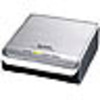This article is more than 1 year old
ZyXEL PL-100 Powerline Ethernet adaptor
Boldly going where wireless and Ethernet can't
Before I started testing the two PL-100s supplied by ZyXEL properly, I plugged one into my wireless router upstairs and took the other downstairs to connect to my PowerBook. I wasn't expecting much - I was just mucking around, really. But it worked immediately, with no need to reboot this, re-connect that. I just turned off the notebook's Wi-Fi adaptor, fired up a browser and started viewing webpages. It was truly a plug and play experience.
It felt fast too. Browsing and downloading aren't ideal network performance benchmarks because the speed you get is dependent on outside factors as well as your local's WLAN's bandwidth. Whatever, accessing the 2Mbps broadband connection felt quicker with the PL-100s than my 802.11g WLAN.
Approaching the issue more scientifically, I set up two machines, a Mac and a PC, one upstairs, one downstairs, and connected them directly using manually set IP addresses (firewalls off) and connecting the Mac to a shared folder on the Windows XP machine. I then copied a series of files from the Mac to the PC, dragging from one folder to the other, and letting both operating systems take care of the rest.
ZyXEL quotes a throughput of 85Mbps, but that's not only a best-case, minimum-noise scenario speed, but it's undoubtedly the raw data speed before the effects of the operating systems and the various data-transfer protocols have taken their cut of the available bandwidth. I got 16.43-16.88Mbps out of the system. I should point out that both notebooks' adaptors were plugged into adjacent power sockets to each PL-100, and my North London flat's mains wiring is probably not the best in the world. It's also has a variety of other appliances hanging off it, potentially boosting the noise the PL-100s' error correction mechanisms have to deal with.
For comparison, I ditched the PL-100s and connected the two computers wirelessly via my Linksys 802.11g base-station. I kept the machines in exactly the same locations. Transferring the same files yielded a bandwidth of 5-6Mbps - around a third of that provided by the PL-100 link.
I was only able to try powerline networking with two machines, but ZyXEL claims each unit will talk to 15 others, and four groups of 16 - 64 clients in all - can operate on the same network.
Verdict
Powerline networking isn't going to replace wireless, but I can see it finding a place alongside it in homes and offices where there's no Ethernet infrastructure, wireless is considered too insecure, there are dead-spots, the airwaves are too full, or users are just too fed up of Windows XP's Zero Configuration system losing network connections.
Crucially, it's cheap: ZyXEL's PL-100 boxes are around £70 including VAT, and you don't have to pay a penny on cables. The PL-100 may not provide the same bandwidth as Ethernet - certainly not Gigabit Ethernet - but it is compatible with the very infrastructure you use to power your computer.
And it's quick, too - faster, I found, than 802.11g Wi-Fi. Unlike Wi-Fi, you have to put your networked devices in fixed locations, but if you're connecting, say, your desktop computer to a remote MP3 gadget plugged into your hi-fi, you're already used to working in specific locations, and you've got the bandwidth you need to transmit audio and even video smoothly. ®

